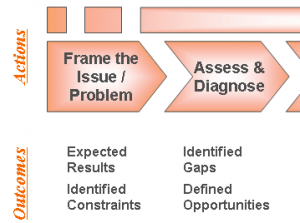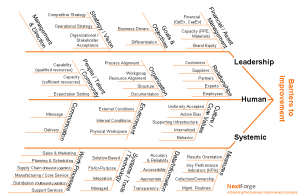We recently discussed our Rapid Assessment Framework (RAF), designed to be used early in the improvement process where there is a need to engage, align, and mobilize a large part of the organization. Here we will provide a more detailed view of the assessment process, which is primarily conducted on-line through a web-enabled tool.  This broad, comprehensive self-assessment is structured on top of a root cause framework of 102 critical dimensions of enterprise health, with the objective of validating and/or determining where deeper, more objective (“focused”) analysis should occur. Key attributes include:
This broad, comprehensive self-assessment is structured on top of a root cause framework of 102 critical dimensions of enterprise health, with the objective of validating and/or determining where deeper, more objective (“focused”) analysis should occur. Key attributes include:
- No pre-determined identification of performance barriers.
- Solicit input from a cross-section of the entire organization.
- Identify common areas of concern as well as any disagreements.
- Based on objective, observable behaviors
- Accelerate the engagement of the organization.
- Develop a shared need for change.
As the RAF is based on a time-tested set of sources and causes of poor performance, and participant input is tied to actual behaviors, it should not be considered a “survey” where users are presented a superficial set of “how-do-you-feel” questions, and where individual scales of “good and bad” can vary.
Experienced consultants and clients alike will recognize this approach, historically applied through an exhaustive one-on-one interview process at the outset of a project. The table below highlights some of the enhancements to data collection that the RAF offers.
 The underlying sources and causes framework consists of 14 major elements grouped by common themes: Leadership, Human, and Systemic. Each of the major elements is further decomposed into more tangible root cause drivers for a total of 102 sub-elements; performance for each sub-element is defined by a range of four observable statements of business behaviors (“best practice” to “no practice”).
The underlying sources and causes framework consists of 14 major elements grouped by common themes: Leadership, Human, and Systemic. Each of the major elements is further decomposed into more tangible root cause drivers for a total of 102 sub-elements; performance for each sub-element is defined by a range of four observable statements of business behaviors (“best practice” to “no practice”).
Utilizing a browser-based polling technology, managers, employees, and other stakeholders record their observations of current and potential enterprise behaviors with a user-defined subset of the root cause drivers they identify as substantial barriers to business performance. Narrative comments can also be collected, and respondents are asked to evaluate the benefit and likelihood of realizing improvement.
This multi-level assessment tool can very rapidly provide a picture for management from different perspectives, including any misalignment between positional and/or functional groups. Results can be viewed in the aggregate or from any combination of demographic splits.
- Statistical feedback (issues selected, priorities, current and potential behavioral scores, opportunity for improvement, chance of success)
- Narrative comments submitted for each major element
- Response rate (if by invitation); number of responses
Company- and industry-specific language can be added to tailor the instrument, and clarity can be validated by first conducting the assessment with a smaller sample (e.g. management team). Individual anonymity is assured, but all responses are tagged with identifiable position/functional groupings.

